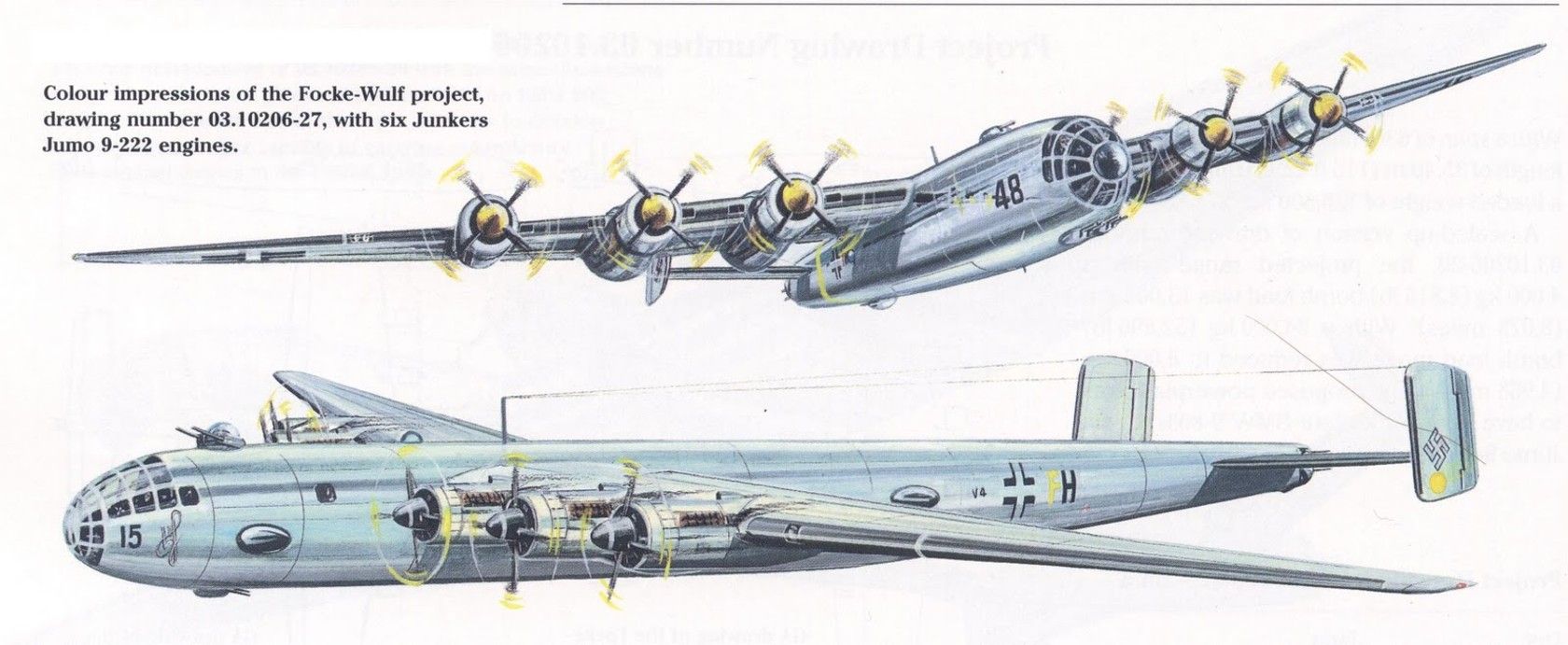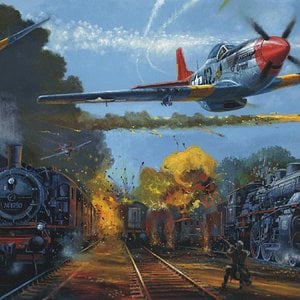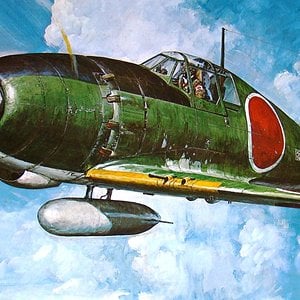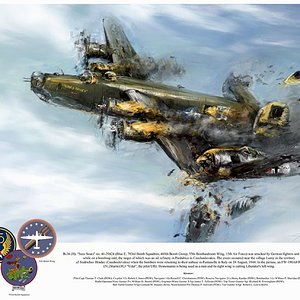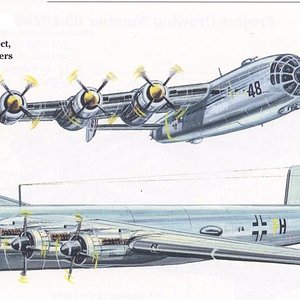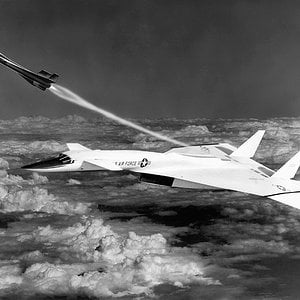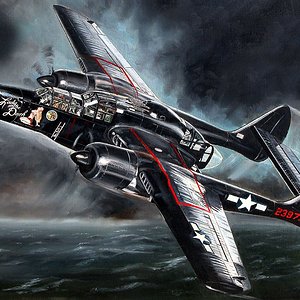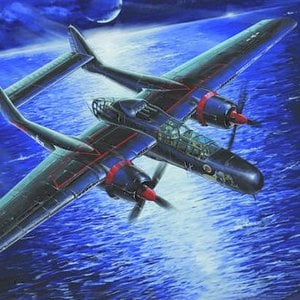Navigation
Install the app
How to install the app on iOS
Follow along with the video below to see how to install our site as a web app on your home screen.
Note: This feature may not be available in some browsers.
More options
You are using an out of date browser. It may not display this or other websites correctly.
You should upgrade or use an alternative browser.
You should upgrade or use an alternative browser.
This Focke-Wulf long-range bomber project (also known under the Focke-Wulf drawing number 03.10206.20) was designed under the same specifications as the Ta 400 and Junkers Ju 390. Basically, an aircraft was needed that could carry a payload of 5000 kg (11023 lbs) of bombs 15000 km (9321 miles). The guidelines set down in March 1941 by the RLM could only be realized if a safe maneuvering load factor of 1.75 could be used on the outboard portion of the bombing mission. This was possible due to the fact that the aircraft's total weight on takeoff included a maximum amount of fuel, which would be used on the way to the target. This would lighten the aircraft and provide a safer maneuvering load factor of 3.2 at the target and on the return flight to base.
The Fw 238 was a large aircraft and was to be constructed entirely of wood. The fuselage was long and boxy, and the wings were tapered on both the leading and trailing edges. Four BMW 803 engines (3900 horsepower each) with counter-rotating four-bladed propellers were to provide the power. A horizontal tail unit with twin fins and rudders was chosen to provide a clear field of fire for the two hydraulically-and-remote-controlled turrets (with two MG 151/20 20mm cannon each located on the upper rear fuselage. There were a further two turrets with similar armament mounted on the rear fuselage bottom, with a provision for a ventral gondola with four MK 108 30mm cannon for the anti-shipping role. All the defensive armament was controlled from the crew area in the forward fuselage. A conventional "tail-dragger" undercarriage scheme was chosen, with the main gear having double wheels and retracting to the rear into the wing. Five crew members (some sources have this number as high as ten) all sat in the extensively glassed-in pressurized cockpit located in the aircraft's nose. The bombload was to consist of 5500 kg (12125 lbs).
Another smaller version was also designed, the Focke-Wulf Fw 238H. The construction and overall design was similar, with differing dimensions, weights and performances given in the tables below. There were actually three different proposed variants (see table below), and if the go-ahead had been given for construction, it is possible that these heavy bombers could have been flying by late-1944. Although many aircraft companies tried to persuade the Luftwaffe leadership of the need for a heavy bomber for the strategic role, the RLM ordered all design work on heavy bombers to cease as of February 14, 1943.
Focke-Wulf Fw 238 - Dimensions
Span Length Height Wing Area Aspect Ratio
Fw 238 52 m
170' 7" 35.3 m
115' 9" 8.7 m
28' 6" 290 m²
3121.5 ft² 9.32
Fw 238H 50 m
164' 1" 30.6 m
100' 4" 5.8 m
19' 1" 240 m²
2583.3 ft² 10.41
Focke-Wulf Fw 238 - Weights
Empty
Weight Crew Fuel Oil Load* Takeoff
Weight Wing Loading Weight/
Power Ratio
Fw 238 55620 kg
122621 lbs 450 kg
992 lbs 49500 kg
109129 lbs 3200 kg
7055 lbs 5760 kg
12699 lbs 114530 kg
252495 lbs 394.93 kg/m²
80.87 lbs/ft² 7.34 kg/hp
16.18 lbs/hp
Fw 238H 24834 kg
54750 lbs 360 kg
794 lbs 28750 kg
63383 lbs 1900 kg
4189 lbs 5256 kg
11587 lbs 61100 kg
134702 lbs 254.58 kg/m²
52.14 lbs/ft² 8.49 kg/hp
18.72 lbs/hp
* includes 256 kg (565 lbs) for cannon ammunition
Focke-Wulf Fw 238 - Performances
Max. speed/Altitude
Cruising Speed/Altitude Range* Climb Rate** Takeoff***
Distance Landing
Speed Max. Flight
Time
Fw 238 670 km/h @ 8000 m
416.3 mph @ 26247'
-----------------------------------------
500 km/h @ 8000 m
311 mph @ 26247' 14100 km
8761 miles 7 m/sec
23 ft/sec 1000 m
3281' 130 km/h
81 mph 29 hours
Fw 238H 400 km/h @ 5700 m
249 mph @ 18700'
-----------------------------------------
310 km/h @ 5400 m
193 mph @ 17716' 15000 km
9321 miles 7.8 m/sec
26 ft/sec 775 m
2543' 110 km/h
68 mph 48 hours
The Fw 238 was a large aircraft and was to be constructed entirely of wood. The fuselage was long and boxy, and the wings were tapered on both the leading and trailing edges. Four BMW 803 engines (3900 horsepower each) with counter-rotating four-bladed propellers were to provide the power. A horizontal tail unit with twin fins and rudders was chosen to provide a clear field of fire for the two hydraulically-and-remote-controlled turrets (with two MG 151/20 20mm cannon each located on the upper rear fuselage. There were a further two turrets with similar armament mounted on the rear fuselage bottom, with a provision for a ventral gondola with four MK 108 30mm cannon for the anti-shipping role. All the defensive armament was controlled from the crew area in the forward fuselage. A conventional "tail-dragger" undercarriage scheme was chosen, with the main gear having double wheels and retracting to the rear into the wing. Five crew members (some sources have this number as high as ten) all sat in the extensively glassed-in pressurized cockpit located in the aircraft's nose. The bombload was to consist of 5500 kg (12125 lbs).
Another smaller version was also designed, the Focke-Wulf Fw 238H. The construction and overall design was similar, with differing dimensions, weights and performances given in the tables below. There were actually three different proposed variants (see table below), and if the go-ahead had been given for construction, it is possible that these heavy bombers could have been flying by late-1944. Although many aircraft companies tried to persuade the Luftwaffe leadership of the need for a heavy bomber for the strategic role, the RLM ordered all design work on heavy bombers to cease as of February 14, 1943.
Focke-Wulf Fw 238 - Dimensions
Span Length Height Wing Area Aspect Ratio
Fw 238 52 m
170' 7" 35.3 m
115' 9" 8.7 m
28' 6" 290 m²
3121.5 ft² 9.32
Fw 238H 50 m
164' 1" 30.6 m
100' 4" 5.8 m
19' 1" 240 m²
2583.3 ft² 10.41
Focke-Wulf Fw 238 - Weights
Empty
Weight Crew Fuel Oil Load* Takeoff
Weight Wing Loading Weight/
Power Ratio
Fw 238 55620 kg
122621 lbs 450 kg
992 lbs 49500 kg
109129 lbs 3200 kg
7055 lbs 5760 kg
12699 lbs 114530 kg
252495 lbs 394.93 kg/m²
80.87 lbs/ft² 7.34 kg/hp
16.18 lbs/hp
Fw 238H 24834 kg
54750 lbs 360 kg
794 lbs 28750 kg
63383 lbs 1900 kg
4189 lbs 5256 kg
11587 lbs 61100 kg
134702 lbs 254.58 kg/m²
52.14 lbs/ft² 8.49 kg/hp
18.72 lbs/hp
* includes 256 kg (565 lbs) for cannon ammunition
Focke-Wulf Fw 238 - Performances
Max. speed/Altitude
Cruising Speed/Altitude Range* Climb Rate** Takeoff***
Distance Landing
Speed Max. Flight
Time
Fw 238 670 km/h @ 8000 m
416.3 mph @ 26247'
-----------------------------------------
500 km/h @ 8000 m
311 mph @ 26247' 14100 km
8761 miles 7 m/sec
23 ft/sec 1000 m
3281' 130 km/h
81 mph 29 hours
Fw 238H 400 km/h @ 5700 m
249 mph @ 18700'
-----------------------------------------
310 km/h @ 5400 m
193 mph @ 17716' 15000 km
9321 miles 7.8 m/sec
26 ft/sec 775 m
2543' 110 km/h
68 mph 48 hours

